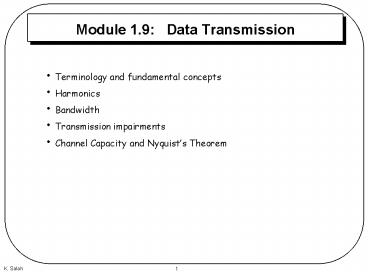Module 1.9: Data Transmission - PowerPoint PPT Presentation
Title:
Module 1.9: Data Transmission
Description:
Various in a smooth way over time. e.g. sound, video. Discrete signal (Digital) ... MDR (noiseless) = 2 w log2 M. M is the values used per signaling state ... – PowerPoint PPT presentation
Number of Views:21
Avg rating:3.0/5.0
Title: Module 1.9: Data Transmission
1
Module 1.9 Data Transmission
- Terminology and fundamental concepts
- Harmonics
- Bandwidth
- Transmission impairments
- Channel Capacity and Nyquists Theorem
2
Terminology
- Medium
- Guided medium
- e.g. twisted pair, optical fiber
- Unguided medium
- e.g. air, water, vacuum
- Simplex
- One direction
- e.g. Television
- Half duplex
- Either direction, but only one way at a time
- e.g. police radio
- Full duplex
- Both directions at the same time
- e.g. telephone
3
Fundamental Concepts
- Time domain concepts
- Continuous signal (Analog)
- Various in a smooth way over time
- e.g. sound, video
- Discrete signal (Digital)
- Maintains a constant level then changes to
another constant level - e.g., text, integers
- Periodic signal
- Pattern repeated over time
- Aperiodic signal
- Pattern not repeated over time
4
Sine Wave (Harmonic) Components
- Peak Amplitude (A)
- maximum strength of signal
- volts
- Frequency (f)
- Rate of change of signal
- Hertz (Hz) or cycles per second
- Period time for one repetition (T)
- T 1/f
- Phase (?)
- Relative position in time
5
Bandwidth
- Bandwidth (in analog communications)
- The total capacity of communications channel
measured in hertz(Hz). - It is the difference between the highest and
lowest frequencies capable of being carried over
a channel. - Any transmission system has a limited band of
frequencies - This limits the data rate that can be carried
- Bandwidth (in digital communications and
networking) - The theoretical capacity of communications
channel expressed in bits per second (bps), which
is called data rate.
6
Analog and Digital Data Transmission
- Signals
- Electric or electromagnetic or light
representations of data. Means of propagating
Data. - Analog Signal
- Represent data with continuously varying sine
wave. - Continuously variable. Various media, e.g. wire,
fiber optic, space - Speech bandwidth 100Hz to 7kHz, Telephone
bandwidth 300Hz to 3400Hz, Video bandwidth 4MHz - Digital Signal
- Represent data with sequence of voltage pulses
- Use two DC components and vary it over time.
Component of zero frequency.
7
Digital Signal
- In RS-232, voltage that varies between -15 and -5
volts is interpreted as a binary 0, and voltage
that varies between 5 and 15 volts is
interpreted as a binary 1. Voltage that varies
between -5 and 5 volts is ignored that is, no
interpretation is made.
8
Analog Signal
- A single frequency with fixed A and ? has 0
bandwidth. It carries no information. However,
when it is combined with other frequencies or its
components become variable, the bandwidth gets
changed.
Amplitude Change
Frequency Change
9
Analog Signal
Phase Change
10
Modem Modulation Techniques
- Usually use digital signals for digital data and
analog signals for analog data - Can use analog signal to carry digital data
- Modem
- Digital signals have a wide spectrum and thus are
subject to strong attenuation and delay
distortion. DC is good for short distances. - Analog signals are used instead with different
modulation of components.
11
Analog vs. Digital Transmission
- Transmission
- Communication of data by propagation and
processing of signals - Analog Transmission
- Analog signal transmitted without regard to
content - May be analog or digital data
- Attenuated over distance
- Use amplifiers to boost signal
- Also amplifies noise
- Digital Transmission
- Concerned with content
- Integrity endangered by noise, attenuation etc.
- Repeaters used
- Repeater
- receives signal
- extracts bit pattern
- retransmits
- Attenuation is overcome
- Noise is not amplified
12
Transmission Impairments
- Signal received may differ from signal
transmitted - Analog - degradation of signal quality
- Digital - bit errors
- Caused by
- Attenuation and attenuation distortion
- Delay distortion
- Noise
13
Attenuation
- Attenuation
- Signal strength falls off with distance
- Depends on medium
- Received signal strength
- must be enough to be detected
- must be sufficiently higher than noise to be
received without error - Attenuation is an increasing function of
frequency - Unlike FM, low frequency (AM) travels very far
14
Delay Distortion
- Delay Distortion
- Only in guided media
- Propagation velocity varies with frequency
- Called also Intersymbol Interference. Due to
delay distortions, some of the signal components
of one bit position will spill over into other
bit positions.
15
Noise
- Additional signals inserted between transmitter
and receiver - Thermal
- Due to thermal agitation of electrons
- Uniformly distributed
- White noise
- Crosstalk
- A signal from one line is picked up by another
- Impulse
- Irregular pulses or spikes
- Short duration
- High amplitude
- e.g. External electromagnetic interference such
as lightning or cut in cable or fault in
communication equipment.
16
Channel Capacity
- Data rate Capacity
- In bits per second
- Rate at which data can be communicated
- Nyquists Theorem
- In 1920, Henry Nyquist discovered that sampling
rate must be at least twice the highest
frequency, in order to construct the original
signal. - Called also Sampling Rate theorem.
- See nice animation at http//www.cs.brown.edu/expl
oratories/freeSoftware/repository/edu/brown/cs/exp
loratories/applets/nyquist/nyquist_limit_java_brow
ser.html - Also, maximum data rate (how much data you can
represent in one signal) of any signal of
frequency w is - MDR (noiseless) 2 w log2 M
- M is the values used per signaling state
- Shannons formula (only thermal noise)
- MDR w log2 (1 SNR)































